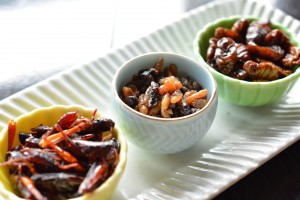 Interview with Dr. Victor Benno Meyer-Rochow, Managing Director and Senior Scientist at the Research Institute of Luminous Organisms, Hachijojima, Tokyo, Japan
Interview with Dr. Victor Benno Meyer-Rochow, Managing Director and Senior Scientist at the Research Institute of Luminous Organisms, Hachijojima, Tokyo, Japan
Many people in the West think that edible insects are widely consumed in Japan. Is it true?
No, this is not true. When after the 2nd World War food was in short supply, many people did consume insects, but now one finds people who regularly consume insects only in the mountainous regions of Nagano, Gifu and Gunma prefectures. Most popular are Japanese grasshoppers (Oxya yezoensis), known locally as ‘inago’, silkworm pupae (Bombyx mori), termed ‘kaiko’, and wasps and their larvae and pupae (Vespula flaviceps), known as ‘hachinoko’. Other insects eaten by some people include cicadas and a variety of aquatic insects and their larvae, collectively known as ‘zazamushi’. However, regarding the total population of Japan, those that do cosnume insects as food are very few and they tend to live mostly in the mountainous regions.
Is this consumption related to traditional use or is it something younger urban generations are fascinated by?
The consumption is entirely due to traditional uses of insects as food, especially in times of need. There may well be also a religious component as Buddhists would traditionally not have killed larger terrestrial animals for food, but this aspect is poorly investigated. Younger generations are not keen on consuming insects as food, although there is a fledgling movement in getting urbanites interested in eating insects, e.g., a monthly edible insect meeting organized by “e-ism”.
Which species are the most eaten in Japan?
Most popular are Japanese grasshoppers (Oxya yezoensis), known locally as ‘inago’, silkworm pupae (Bombyx mori), known as ‘kaiko’, and wasps and their larvae and pupae (Vespula flaviceps), known as ‘hachinoko’. Other insects eaten by some people include cicadas, some wood-grubs, and a variety of aquatic insects and their larvae, collectively known as ‘zazamushi’ and comprising larvae of mayflies, stoneflies, caddisflies, alderflies, etc. collected from mountain streams. Giant waterbugs used to be eaten by a few people, but these insects are now protected and very rare in Japan.
What’s the role of edible insects for our future food-security?
Edible insects have the potential to make a contribution (already suggested as far ago as 1975 in an article by Meyer-Rochow), but are not likely to ever replace conventional meat sources. Very few insects are outright inedible or poisonous and most of the edible species are neither more nor less nutritious than conventional meat, but they do require far less space, feed, and water when ‘farmed’ than conventional domestic animals. Moreover, about 75% of an edible insect is usable as food and that is a far greater percentage than what we get from our conventional suppliers of meat. The high reproduction rate of edible insects is another positive aspect and the fact that many conventional food animals (poultry and hogs for example) can be fed insects and grow well on such a diet must also be seen as an advantage.
The western approach to “huge volumes” is: big factories and mechanization. Is this the only solution or huge volumes of edible insects can be farmed by a net of smaller farmes workink under the same protocols?
Yes, farming or rearing insects under a “net of smaller farmers” working under controlled and hygienic conditions is a possibility. The irony of this is that western enterprises ‘learned’ about insects as human food from traditional societies largely based in developing countries, but the western approach of large scale farming, use of modern technology, automation, etc. makes it likely that western based companies will export and sell processed insect-based food to the very countries that the idea to use insects as food originally came from.
What’s the best communication strategy to to make the consumers overcome the “yuk factor”?
Best strategy is to avoid linking food insects with species known to be disliked by humans (like cockroaches, maggots, etc.) and places that disgusting insects occur (e.g., corpses, faeces, etc) or with diseases transmitted by insects. Linking edible insects with highly appreciated species and their products like honey bees helps too and avoiding names like ‘worms’ for insects is important. The best way is to present insect-based foods in ways that no-one can see or identify the insect in it, just like nobody ‘sees’ the pig when eating a sausage or the fish when eating a ‘fish-stick’. Also presenting insects not as an ’emergency food’ for poor people, but as a food rich in nutrients and carefully bred under hygienic and conrolled conditions will help.
Do you think edible insects will soon be normalized in the western countries?
Normalized yes; mainstream food no. There is this ‘neophilia’ aspect, which means there is curiosity in trying something new and that will lead some entrepreneurs, falsely, to think edible insects will have a bright future in western countries. I do not think so: we already have an overproduction of food and heaps of obese people. The use of insect-based flours in breads, cakes, biscuits, crackers, etc. does have a future, but whole insect-containing pickles, salads, soups, etc will be much harder to promote and gather a following. However, who would have guessed 30 years ago that raw fish ‘sushi’ would be able to make such inroads into the European food culture? Perhaps the next big food revolution will see rats and rat-based sausages on our plates. It’s entirely possible.





